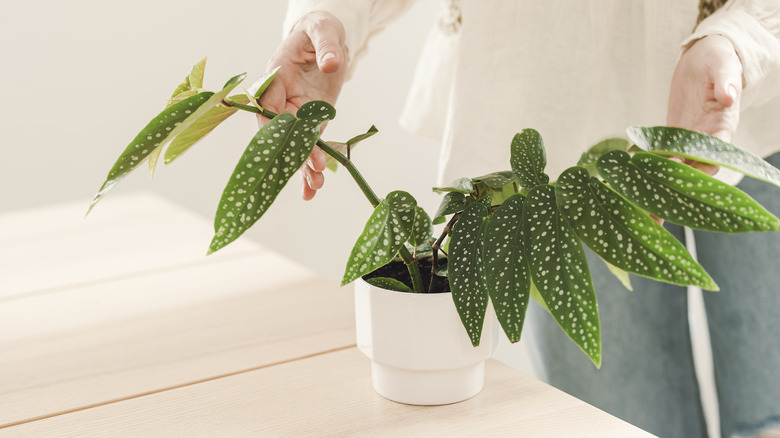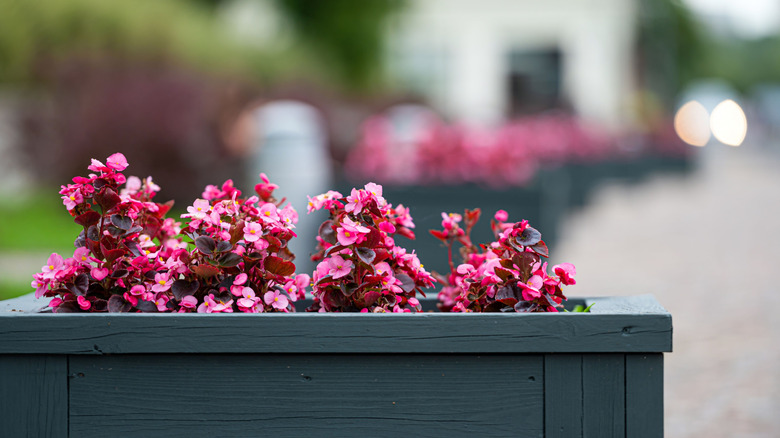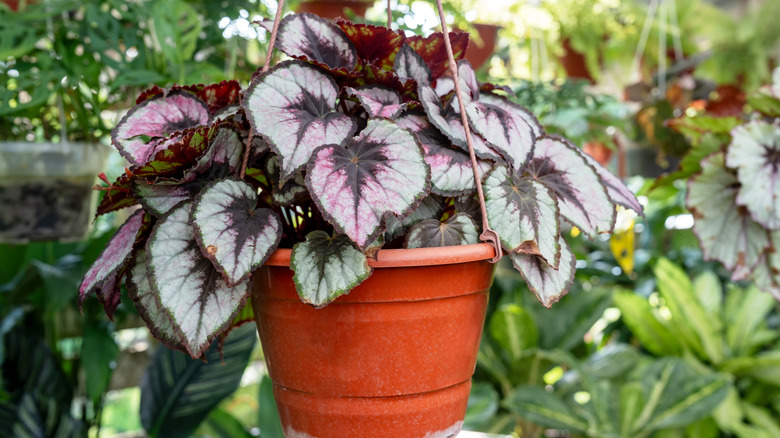The Right Way To Transition An Outdoor Begonia Plant Indoors For The Winter
Not only is it easy to grow some types of begonias in your home, they also offer the most breathtaking sights in a garden with their heavenly blooms and striking foliage. No wonder they are tucked into seemingly every spot possible for a plant — be it in garden beds, hanging in wall baskets (or stunning DIY hanging planters), or in pots or containers. Considering these amazing qualities, it is understandable that you would not want them to disappear all of a sudden over the winter. Although many begonia varieties can be brought indoors to survive the winter as houseplants (tuberous begonias need a period of dormancy to survive and are better suitable for overwintering as tubers), you can't be reckless with the transition. The right way to move begonias indoors involves digging them up during fall (before frost hits), getting rid of any pests, transplanting them to pots, and acclimating them for a few weeks to the indoor environment before permanently moving them.
When it comes to choosing the right time, you can consider bringing your begonias in once the temperature starts falling during fall (below 60 degrees Fahrenheit during nights). This transition period is also a good time to rid them of any possible pest infestations. Even if you're growing your begonias in containers, you can take them out, inspect the roots for pests, and wash the plant with insecticidal soap to keep them healthy. The right way to transition begonias also depends on the type you're growing — some are grown for their foliage, others for flowers; some are tuberous, while others are fibrous-rooted and waxy. Before you bring your plant indoors, make sure you pin down its type and care for it accordingly.
Transitioning wax begonias indoors
For wax begonias, making the transition is fairly simple. The fact that these begonias are not frost-tolerant means you'll need to bring them indoors before the first frost hits your region. If your begonias are growing in the ground, you will have to transplant them in a pot or a container first. However, just like you need to harden off seedlings before you put them outside, acclimating plants before changing their location from outdoors to indoors is equally crucial. Wax begonias often punish you by dropping leaves if you skimp on this process. If you're living in the colder, northern regions of the country, it's especially important to give your begonias some time to adapt. Indoor furnaces significantly lower the humidity levels in the house, and plants need to adjust to the change.
For the first week or two of the adjustment process, move the wax begonias to a different spot outdoors that only receives partial sun. Then, a couple of days per week, bring the plants inside. After that, you can give them their permanent winter spot near a window that receives as much indirect sunlight as possible. You can also use a grow light for the purpose, for about 8 to 10 hours a day. Place the light a few inches above the plant and both warm and cool colors to ensure both its flowers and foliage grow optimally. Feeding wax begonias during the winter is not needed as long as the potting medium contains fertilizer. However, if you begin to see yellowing of leaves, you can use a balanced 10-10-10 fertilizer for your begonias at half the strength than normal to make them thrive again.
Transitioning flower begonias, foliage begonias, and tuberous begonias indoors
Foliage begonias (those grown primarily for their attractive leaves) need to be acclimatized just the same as wax begonias, and kept in a bright place away from direct sunlight. Flowering begonias, on the other hand, can tolerate direct sunlight as well, especially in the morning. Keep the soil in the pots moist during the entire winter season and the room temperature between 66 to 73 degrees Fahrenheit. You can use a humidifier to maintain humidity levels for these plants.
Overwintering tuberous begonias can take more effort, but it is worth seeing the plant come back to life next spring and reward you with breathtaking blooms year on year. Since these begonias are highly sensitive to temperatures below 45 degrees and cannot survive freezing at all, you need to dig up the tubers before the first killing frost. This is especially the case if you're in USDA Zones 7 or lower.
Next, cut back the tubers' stems to about an inch long. Tubers then need a period of two to three weeks to cure in a cool and dry location. During this period, make sure the tubers are stored at room temperature away from any direct sunlight. The ease with which the stems detach themselves can tell you if the tubers are dry enough or not — if you're having trouble removing them, the tubers need more time to dry.
Once the curing period is over, shake off any excess soil (without washing the tubers) and place them in a cardboard box filled with peat moss or vermiculite. Cover them with a layer of peat as well, and keep them between 40 to 50 degrees Fahrenheit. Next spring, once the weather stays above 50 degrees Fahrenheit, they can be replanted.


